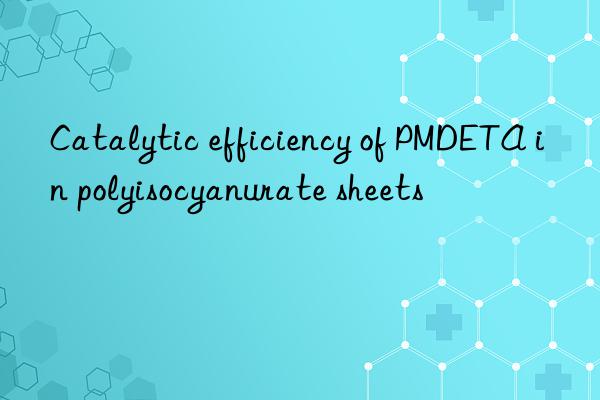
PMDETA, full name N,N,N’,N’,N”,N”-Hexamethyldiethylenetriamine (hexamethyldiethylenetriamine) , is an efficient organic catalyst, especially playing a key role in the chemical reaction of polyurethane (PU). When applied to the production of polyisocyanurate (PIR) sheets, the catalytic efficiency of PMDETA is directly related to the foaming quality, physical properties and production efficiency of the sheets. This article will explore the catalytic mechanism, influencing factors and performance optimization of PMDETA in polyisocyanurate sheets.
Catalytic mechanism
In the synthesis process of polyisocyanurate sheets, PMDETA mainly catalyzes the reaction between isocyanate groups and water, that is, the foaming reaction, and also helps balance the gel reaction. PMDETA promotes the contact between isocyanate groups and water molecules by donating protons or accepting protons, accelerating the generation of carbon dioxide, thereby producing foam. In addition, it participates in the cross-linking reaction between isocyanate groups to form a polyurethane network, which is called a gel reaction.
Factors affecting catalytic efficiency
The catalytic efficiency of PMDETA is affected by many factors, including but not limited to temperature, reactant concentration, pH value of the reaction medium, and the concentration of PMDETA itself. Increasing temperature usually increases catalytic efficiency, but too high a temperature may lead to the occurrence of side reactions; changes in reactant concentration will affect the relative proportion of the catalyst, thereby affecting catalytic efficiency; adjustment of pH value can optimize the active state of the catalyst; PMDETA The concentration directly determines the strength of its catalytic ability.
Performance optimization
The application of PMDETA in polyisocyanurate sheets can significantly improve the performance of the sheets. First, the strong foaming effect of PMDETA improves the fluidity of the foam, making the board more uniform during the molding process and reducing the problem of uneven internal pores. Secondly, the use of PMDETA helps control the density and closed cell ratio of the board, thereby improving its thermal insulation performance. Thirdly, due to the efficient catalytic effect of PMDETA, the production cycle of the plate can be shortened, the production efficiency is improved, and the energy consumption is also reduced.
Practical applications and challenges
In actual production, the addition amount of PMDETA needs to be precisely controlled to achieve excellent catalytic effect. Too much PMDETA may cause over-foaming of the foam and affect the mechanical strength of the board; while too little may cause insufficient foaming and reduce the thermal insulation performance of the board. Therefore, manufacturers need to adjust the amount of PMDETA according to specific process conditions and plate specifications to achieve excellent performance.
Conclusion
PMDETA’s catalytic efficiency in the production of polyisocyanurate sheets is crucial to ensuring the quality and production efficiency of the sheets. By finely adjusting the catalytic conditions, the catalytic effect of PMDETA can be improved, thereby producing high-quality polyisocyanurate sheets with good thermal insulation properties, high strength and low thermal conductivity. With the continuous development of the polyurethane industry, the demand for efficient catalysts is growing day by day. As a catalyst with excellent performance, PMDETA will play a more important role in the production of polyisocyanurate sheets in the future, promoting technological innovation and development in the industry. product upgrade.
Extended reading:
bismuth neodecanoate/CAS 251-964-6 – Amine Catalysts (newtopchem.com)
stannous neodecanoate catalysts – Amine Catalysts (newtopchem.com)
polyurethane tertiary amine catalyst/Dabco 2039 catalyst – Amine Catalysts (newtopchem.com)
N-Methylmorpholine – morpholine

 微信扫一扫打赏
微信扫一扫打赏

